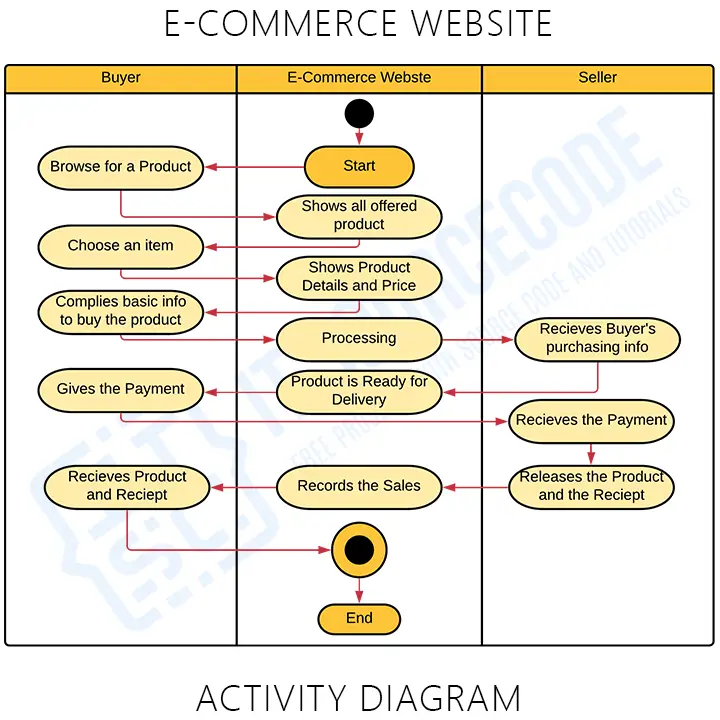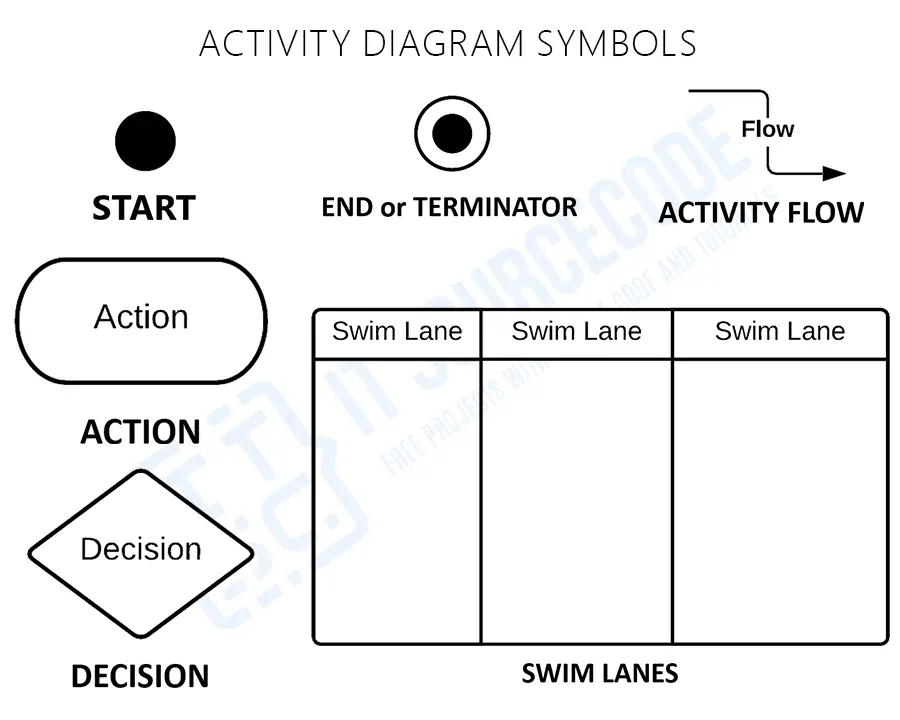The activity diagram for e commerce website is one of the behavioral diagrams based on UML. It shows the system’s behavior by presenting the flow of activities from one process to another. The possible flow of activities can be in order, split, or continuous.
The E-commerce Website Activity Diagram is build-up of activities, decisions, and paths. It uses symbols to define the overall workflow of activity diagram.
Activity Diagram illustrates the E-Commerce Website’s behavior in terms of interacting with its users. UML Activity Diagram also gives bright ideas and guides the project proponents throughout the software development.
E-commerce Website Activity Diagram: Project Name and Details
The table shows the project name and details of activity diagram of e-commerce website. It has the complete information of the project.
| Name: | E-commerce Website Activity Diagram |
| Abstract: | The E-commerce Website Activity Diagram represents the behavior of the project in terms of its activities. It contains the important details on the activities and constraint done in the project. |
| UML Diagram: | Activity Diagram |
| Users: | Admin, Sellers, and Buyers |
| Tools Used: | Diagram tools that provides activity diagram symbols. |
| Designer: | ITSourceCode.com |
Importance of E-commerce Website Activity Diagram
The importance of E-commerce Website Activity Diagram is that it enables interaction between developers and clients. This is done by helping them visualize the system’s functionality in various degrees of detail.
The activity diagram involves major activities to define the workflow of the project. These activities comes with user decisions that results to more effective interaction. Being a programmer, these are the important roles that the E-commerce Website should have.
E-commerce Website Activity Diagram: Benefits
The E-commerce Website Activity Diagram Benefits are as follows:
- Helps in understanding how the project’s algorithm works.
- It describe the steps that a UML use case takes.
- Shows how users and the system interact in a process or workflow.
- Clarify difficult use cases to simplify and improve any process.
Activity Diagram for E-commerce Website [PDF]
The Activity Diagram for E-commerce Website is given to expound its ideas. Its’ activity diagrams are shown in different scenarios and is based on its users.
E-Commerce Website Activity Diagram (Seller Side) – The E-Commerce Website concept is to host the sellers to sell their products in the website. Then with use of the website, customer can easily access their desired products with just logging in into it. Here’s the potential series of activities using the E-Commerce Website concept.

In developing the E-Commerce Website UML Activity Diagram, you must know about e-commerce activities. The Activity Diagram is used to illustrate the website’s structure and will be the basis for its development. You must be careful when designing it to avoid making errors.
As shown in the figure, there are multiple user-website interactions. This signifies they’re part of e-commerce transactions. But keep in mind that these are traditional activities, so you can innovate if you want to.
E-Commerce Website Activity Diagram (Seller and Buyer Side) – This diagram shows the flow of activities when a buyer and seller get to communicate through the website. It clarifies the included processes and the exchange of request between the buyer and the website as well as the seller.

The activity diagram for both buyer and seller side is designed based on actual activities that happens when you shop online. The concept was made automatic and accessible with the use of the e-commerce website. Its’ purpose is to provide more convenient way for shoppers to buy their needs without going out and exerting effort to buy something.
You can have the PDF file of this discussion by clicking through the button.
Draw the Activity Diagram for E-Commerce Website using UML Tool
Time needed: 5 minutes
Steps in creating an Activity Diagram for Ecommerce Website.
- Step 1: Familiarize Activity Diagram Symbols
Activity Diagram Symbols – are used to create an Activity Diagram which were presented here. Their symbols and applications must be familiarized before you build the Activity Diagram.

• Start – is the beginning of the action is symbolized by a filled circle. A dark circle represents the initial node.
• Action – is a stage of an activity in which users or software accomplish a certain task. Actions are represented by round-edged rectangles.
• Decision – represent by a diamond and is used to symbolize a conditional branch in the flow. It has two or more outputs and a single input.
• Swim Lanes – are the lanes drawn as boundaries, and the activities drawn in the same lane as the organization’s activities. Swim lanes must be arranged in a logical order.
• Activity Flow – is another name for the connectors in the diagram that illustrate the flow between processes (activity).
• End or Terminator – is the last phase of the activity. An indicated black circle represents the final node.
Each of these activity diagram symbols shows the overall System behavior. Emphasizing the System’s behavior would be much easier by using these Activity Diagram symbols. - Step 2: Determine the targeted users
After the symbol familiarization, you’ll need to determine your targeted users. Your targeted users will be the ones to use your project.
Your project is E-commerce Website, then your users would be the admin, sellers and the customers. You may ask them of the common activities that they do when doing task in recognizing faces. These information will help you in proceeding with the next step. - Step 3: Analyze the activities included
Analyzation is very important in creating an activity diagram. It will help you understand the work of the diagram and avoid the unwanted errors.
The gathered information from the targeted users are very useful in creating an activity diagram. You just need to evaluate these data and pick the general activities.
From the general activities, you will see the specific activity that are included in it. But only include the useful activities and decisions (circumstances) related to website management. Then you’re ready for the next step. - Step 4: Plot the Activity Diagram
To plot the activity diagram you will need the users, activities, decisions, and their flows (paths). You will base the flow of activities from the evaluated information to have the exact Activity Diagram.
To plot your Activity diagram, you need to place first the users involved and the process they will perform.
Then place the figured activities or steps included in doing the process.
After that, you will trace the flow or path of activities to know the series of interaction between the user/s and the system.
Finally, you put the swim lanes or the partition in the plotted diagram to separate the objects’ (users and system) activity. This is to identify what are the activities or decisions that are under them or should be performed.
Conclusion:
You must know the diagrams used to create and construct the E-Commerce website. because you can’t develop a fully functional system without it. If you develop this activity diagram, you’ll know the actions and situations the system should process and complete. You’ll also identify the needed processes and connect them to other UML diagrams.
By completing Activity Diagrams for every module or per process, you’ll simply accomplish your desired system. The E-Commerce Website activity diagram stays the same as its concept. You may constantly refine and reinvent the idea, but you can’t change its foundation.
Related Articles
- E-commerce Website DFD (Data Flow Diagram)
- Sequence Diagram for E-Commerce Website
- E-Commerce Website Class Diagram
- Use Case Diagram for E-Commerce Website
- ER Diagram for E-commerce Website
Inquiries
If you have inquiries or suggestions about Activity Diagram for E-commerce Website, just leave us your comments below. We would be glad to hear to concerns and suggestions and be part of your learning.
Keep us updated and Good day!


